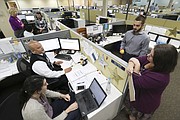It takes a while to figure out some of the signs atop the cubicles in the big room off Riverside Drive where 100 Erlanger employees and consultants are in the middle of a $100 million project that will touch the lives of every patient, doctor and staffer at the metro area's largest hospital system.
One reads "ASAP," another "Cupid," and a third "Stork."
ASAP is for the emergency room, explains Gail Maynor, one of the managers of the project. Stork is for babies, so that would be pediatrics. And Cupid is for the heart, or cardiology.
But while the names may be whimsical, the work being done here is not.
Erlanger is in the middle of one of the most difficult and expensive projects in the hospital's history, spending $100 million over 10 years to get rid of paper records and pull all the hospital system's myriad computer programs into one big network.
It's a project with the potential to improve patient safety and access to medical records, and it's an attractive target for hackers who want to steal private data. The finished product, called eChart, may boost hospital productivity, but at the risk of some veteran doctors throwing up their hands and retiring early rather than changing their long-established habits.
There are concerns about privacy and worries from many doctors that moving to an electronic records system means they will spend less time talking face to face with patients and more time typing into computers, a skill they were not taught in medical school.
And there is just the sheer scope of the work itself. Almost every single procedure in every corner of five hospitals, six emergency rooms and 46 doctors' offices needs to be captured and converted to the new system in a way that convinces the doctors and nurses and technicians and administrators who will use it that it is improving their work lives.
Erlanger also has more than 200 staff physicians whose work must be converted to the system.
Some 1.2 million existing records are being imported into eChart, with staffers checking to be sure the data is captured correctly. Paper documents that would fill entire buildings will be reduced to an estimated 44 terabytes of computer files that will be stored on a group of servers about the size of an elevator car.
Will it be worth it?
"It will allow us to provide safer, more efficient care," said Dr. Stephen Adams, who represents the hospital system's doctors in developing the new software. "We have a world-class stroke treatment program here. Wouldn't it be great to have a world-class system for preventing medication errors even being entered into the system, let alone given to a patient? We need this kind of software to be that kind of hospital."
Parkridge Health System already has its own electronic health care records system, or EHR, but it is proprietary, shared with all the 177 hospitals owned by parent company HCA. CHI Memorial began work this month to choose a new electronic records software system.
Erlanger now uses at least six different computer systems, according to Adams, who is the chief medical informatics officer. When patients come into the emergency room, their information is logged into one. When they are moved to a bed in the hospital, they shift to another system. The radiology department, the place where X-rays or CT scans and MRI scans are taken, uses its own system. In-patient accounting is in one system, outpatient accounting is in another.
The concern is that medical staff in one department may not know what others are doing.
"The patient in the emergency department may get medications and, when they come to the inpatient side, the nurses at their bedside can't see what was given there," said Jan Keys, Erlanger's chief nursing executive. "They have a verbal report and we ask the emergency department to print off everything they did. So the nurse has to sift through this documentation to see what they need to know. That contributes to a lot of nurse fatigue and burnout."
Patients now don't have much access to any of the information the hospital is gathering about them.
When the new system is finished, patients will have their own MyChart pages where all the information they need to know about their care is collected and can be explained before they are sent home.
"If we're sending you home, we want to be sure you have access to your data," said Maynor, director of clinical informatics for eChart. "You can give your family access."
Patients also would be able to send questions to a nurse, for example, or access information on how to take their medications. The information could be shared with doctors elsewhere.
But for now, eChart is a little more than six months away from its rollout.
Staffers have begun to import data from the hospitals' existing records and checking to see if it transfers correctly. Even things that should be simple can reveal headaches, Maynor said. If a patient had no Social Security number, for example, staffers in the past might enter a nonsense number, such as 999-99-9999. If the system demanded a phone number and the patient did not have one, 123-456-7890 might be entered instead. But now the new system is kicking out records because they have identical Social Security or telephone numbers, Maynor said.
Erlanger purchased a basic software package from EPIC, the company that has the largest share of hospital computer systems nationwide. But now the basic EPIC system must be customized to match the way Erlanger's staffers operate.
What is key is to capture the way doctors and nurses work, so the system reflects their needs. To do that, Erlanger is assigning several top doctors and nurses with the software development team.
"If that doesn't happen, then you're already lost with adoption before you get there," Keys said. "The staff won't adopt it if they don't have input into it. Particularly with nurses, they will dig their heels in. That is why we needed to put some of our best folks over there."
Ever since most hospitals began the move to electronic health care records several years ago, doctors nationwide have made no secret of their frustrations.
"Doctors seem to hate this. Nothing is as fast as dictating a note or writing on a piece of paper," Adams said. "To get physicians to buy in, you have to show them value. The value comes in patient safety and reduced unnecessary use of resources. If you can show them those things, they are willing to accept the trade-off."
The eChart system will begin rolling out in May, and Maynor said Erlanger hopes to have one support staffer for every two doctors initially.
"We will tell them that 'We know it's hard for you at first, it does take more time,'" she said. "But the data you can retrieve from it for the patient's next visit was far better than what you could do before."
"I could barely read my writing," Maynor hopes doctors will say. "... now I can."
Contact staff writer Steve Johnson at 423-757-6673, sjohn son@timesfreepress.com, on Twitter @stevejohnsonTFP, and on Facebook, www.facebook.com/noogahealth.

